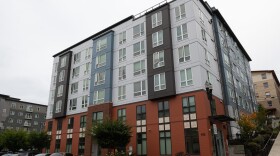The City of Tacoma is depending on state funding to keep more than 300 homeless-shelter beds open, but, after the state Legislature proposed its operating budgets Monday, the city is not sure if the money will come through.
“The City is continuing to review the budgets that were released today by the Senate and the House,” Maria Lee, a spokesperson for the City of Tacoma, told The News Tribune on Monday. “We are not seeing a separate line item for shelter funding for Tacoma in either budget, but are continuing our review to understand whether the funding is included as part of one of the grant programs for homeless housing programs.”
At the end of 2024, the city anticipated the stand down of nearly 400 shelter beds by the end of 2025. The city’s homelessness strategy, which was drafted in 2022, calls for the city to transition away from emergency shelter and increase its permanent supportive-housing capacity.
In an interview in December, deputy city manager Sonja Hallum told The News Tribune that when the strategy was adopted the city did not anticipate having the demand for temporary shelter that it currently does.
The City of Tacoma reported more than 1,000 people stayed in homeless shelters during the month of February 2025.
Heading into the 2025 legislative session, Tacoma requested roughly $6 million to keep roughly 300 shelter beds operational through 2025.
On March 6, Lee told The News Tribune the city hoped to receive funding from the Legislature to maintain 307 beds across five key shelter locations.
Those locations are Bethlehem Baptist Church, Tacoma Emergency Micro-Shelter Site #3, Holy Rosary Safe Parking, Forging Path Community and Freedom Project.
“This state funding is critical to maintaining our existing temporary and emergency shelter locations which are necessary to provide safe and supportive environments for families and individuals experiencing homelessness,” she told The News Tribune in an email. “While these shelters are currently scheduled to stand down on June 30, 2025, without state funding, we are actively advocating for the resources necessary to maintain these essential services.”
Caleb Carbone is the homeless strategy, systems and services manager with the City of Tacoma’s Neighborhood and Community Services Department.
During a Tacoma City Council study session on March 18, Carbone said the city hoped to receive enough funding to maintain the 307 shelter beds through the first half of 2027.
Two shelters are slated to stand down regardless of whether the city receives additional state funding. Theclosures were within the city’s long-term plans to transition away from temporary shelter and towards permanent supportive housing.
The shelter at Altheimer Memorial Church will close by the end of June 2025. Lee said the city is working to find places for those currently staying there to go.
“At Altheimer’s Give Me a Chance Family Shelter, we are providing intensive case management and support to the 36 residents, ensuring they have access to housing plans and alternative shelter options by June 30, 2025,” Lee told The News Tribune on March 6.
Lee said the shelter at Altheimer Memorial Church has served 239 individuals since 2020.
The homeless shelter operated by Shiloh Baptist Church and Valeo Vocation is set to close on March 31. The shelter there serves single men and has 40 beds. According to Lee, the shelter has served more than 300 individuals since 2021.
During the March 18 study session, Carbone told the City Council the church and Valeo Vocation were working to transition the individuals staying at the shelter into permanent supportive housing or other temporary solutions.
Carbone said Shiloh Baptist Church would continue to focus on providing housing services with its New Life Apartment affordable housing program after the men’s shelter closes. That project is leasing and provides housing services as needed for people who are at or below 60% AMI.
With the potential loss of shelter beds, the city’s capacity would be reduced to 720, according to Carbone.
In December, Hallum said the nearly 400 beds set to disappear in 2025 represents a “significant” portion of the city’s roughly 900 shelter beds. With Tacoma hosting what Hallum said was about 80% of Pierce County’s shelter capacity, she said the loss of shelter would have county-wide implications.
Jake Nau is homeless outreach case worker for St. Vincent de Paul’s Community Resource Center in Tacoma. He works with folks living unsheltered in Tacoma and tries to get them off the streets.
When asked about the shelter closures impact, Nau told The News Tribune it would both make his job harder and negatively impact those living unhoused.
“The [city’s] narrative that they are housing these folks and so the stand down won’t negatively impact our unhoused community is silly,” Nau said “There are already far more unhoused people then shelter beds in Tacoma and this will make it worse.”
This article was first published by the Tacoma News Tribune through the Murrow News Fellow program, managed by Washington State University.






